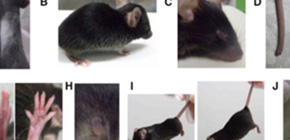
Mouse Evolution Project reveals germline mutation rates and the long-term phenotypic effects of mutation accumulation
Mutant mice also born which will prove useful in development of treatment methods for various disorders
A group of researchers led by UCHIMURA Arikuni , Specially Appointed Assistant Professor of the Graduate School of Frontier Biosciences, Osaka University, succeeded in breeding mice with characters different from those of normal mice at a high frequency and measuring the mutation rate per generation in laboratory mice, a world first. This group also clarified that mutation with similar characteristics takes place in germlines of humans and mice.
This group repeated the passage of normal laboratory mice and mutator mice whose mutation rate at the time of DNA replication was increased by genetic modification over 20 generations for 9 years and analyzed how increased germline mutation rates affected groups in later generations.
This group's achievements are thought to be important in considering the future risk of mutation in humans. In this group's research, many individual mice manifesting disorders also seen in human beings, such as hydrocephalus, cataracts, psychiatric disorders, muscular dystrophy, allergic symptoms, kidney impairment, progeria, and abnormal spermatogenesis, were also found. Furthermore, mutant organisms with novelty characteristics, such as mice singing like a bird, were born. Various mutant mice born through this group's research will be helpful in developing therapeutic methods for human diseases.
Abstract
The germline mutation rate is an important parameter that affects the amount of genetic variation and the rate of evolution. However, neither the rate of germline mutations in laboratory mice nor the biological significance of the mutation rate in mammalian populations is clear. Here we studied genome-wide mutation rates and the long-term effects of mutation accumulation on phenotype in more than 20 generations of wild-type C57BL/6 mice and mutator mice, which have high DNA replication error rates. We estimated the base-substitution mutation rate to be 5.4 × 10 −9 (95% confidence interval = 4.6 × 10 −9 –6.5 × 10 −9 ) per nucleotide per generation in C57BL/6 laboratory mice, about half the rate reported in humans. The mutation rate in mutator mice was 17 times that in wild-type mice. Abnormal phenotypes were 4.1-fold more frequent in the mutator lines than in the wild-type lines. After several generations, the mutator mice reproduced at substantially lower rates than the controls, exhibiting low pregnancy rates, lower survival rates, and smaller litter sizes, and many of the breeding lines died out. These results provide fundamental information about mouse genetics and reveal the impact of germline mutation rates on phenotypes in a mammalian population.
Fig. 1. Strategy of the present study. The breeding of mutator mice that have an increased spontaneous germline mutation rate provides an efficient experimental model with which to study the expression of genetic variation and its maintenance in a population. Illustrations of mice were kindly provided by Dr. Masuya (RIKEN BRC, Japan).
Fig. 2. Phenotypic anomalies observed in mutator mouse lines. (A)-(F) Photographs of typical, frequently observed anomalies, including (A) minor color, (B) hydrocephaly, (C) closed eye, (D) cut tail, (E) tail kink, (F) cataract. (G)-(K) Inherited anomalies, including (G) syndactyly (right photograph shows a normal paw), (H) priapism, (I), short limbs and tail (right photograph shows a normal mouse), (J) color dilution (left), and (K) a human-audible vocalizer.
Table 1. Mammalian mutation rates and their effects on survival
Fig. 3. Relationship between 8-week-old male body weight (A) or live offspring per mating (B) and generation number (red: mutator; blue: control). Dots: individual mice; circles, mean for the generation. Solid line: simple linear regression of the posterior means. Green line: regression curve using the recessive lethal mutation model for the mutator lines.
To learn more about this research, please view the full research report entitled "Germline mutation rates and the long-term phenotypic effects of mutation accumulation in wild-type laboratory mice and mutator mice" at this page of the Genome Research website.
Related link
